John Hurrell – 6 November, 2012
Rob Garrett's curated exhibition, Lost in a Dream, involving fourteen artists from eight countries (many from Eastern Europe), was an unusual occasion - an ambitious examination of the theme of the active imagination, in particular mental fantasy that ambiguously bleeds like a blurry shadow into ‘stable' reality. He cleverly downplayed any notion of ‘dream' being clearly isolated or discreetly separate from ‘wakefulness'.
Auckland
International group show
Lost in a Dream
Curated by Rob Garrett
19 October - 3 November 2012
Initially planned to be a week longer, this show closed prematurely with the gallery premises suddenly abandoned in order to be handed over for demolition - and the Snake Pit team looking for a new cheap innercity venue for exhibitions, studios and perhaps concerts.
Despite the truncation of its exposure, Rob Garrett’s curated exhibition, Lost in a Dream, involving fourteen artists from six countries (many from Eastern Europe), was an unusual occasion - an ambitious examination of the theme of the active imagination, in particular mental fantasy that ambiguously bleeds like a blurry shadow into ‘stable’ reality. He cleverly downplayed any notion of ‘dream’ being clearly isolated or discreetly separate from ‘wakefulness’.
Garrett’s interest in such mental confusion as a basis for selecting sculpture, paintings, videos and photographs had a wide sweep - perhaps making it so inclusive as to be meaningless, as if no potential choice could ever be left out. Naturally some of it was surreal (referencing art or film history), or alluding to psychological instability.
Selections involved geometric abstraction that mentally extended rendered forms into space beyond the edges of the painting or towards the viewer, videos with mushy sentimental reverie, painting with oblique references to cinema, or sculpture to painting, and cabriole legged coffee tables converted via glued on seashells to whimsical kitsch. The types of ‘dream’ presented - demonstrating on Garrett’s part a freewheeling conceptual ‘elasticity’ - surprised with their variation.
Olga Chernysheva‘s black/white video, The Train, is a good example of Garrett’s interest in mixing apparent opposites. It blended together shots of different carriages, from different trains and even (I suspect) different track gauges - and a hospital corridor - to make a discordant but exciting journey through day and night, while introducing us to various beggars, itinerant musicians and a poet reciting Pushkin. A Mozart concerto played in the background of this subtly incongruous composite, propelling us along as we moved towards the engine up through the carriages.
Berlin artist, Katrin Kampmann, makes complex but delicate portraits from film stills, using watercolour mixed with shellac to create strange puddle forms with raised ridges. One of her three images was of Rheya, the beautiful chimaera in Tarkovsky’s 1972 film Solaris, the protagonist’s long dead wife who keeps reappearing in his spaceship. Here the unusual medium cleverly paralleled the fluid material properties of the subject matter.
Alexander Ilin is a Russian photographer now living in Auckland who presented a suite of nineteen portraits of patients under care in a mental hospital run by the former Soviet Union. Some were living in a security wing under close scrutiny by doctors, others lived on their own in a separate nursing home. From the images we were asked to ponder who was comparatively healthy and who was ill - challenging the notion that such clinical conditions could be easily detected in a photograph.
Cecile B. Evans’ video of herself using sign language for the deaf to elucidate the lyrics of Paula Abdul’s late eighties hit Straight Up, while getting slowly inebriated, was too subtle to grasp as there were no vocals or subtitles to measure her ‘semaphores’ against, and the tune was slowed down. Nevertheless the increasing spinkles of ‘fairy dust’ and vague lack of synchronicity, along with seductively dreamy music and the artist’s good looks, made it compelling viewing.
Paul Hartigan’s neon contribution in Snake Pit’s High Street vitrines made a lot of sense for this show if you saw it late at night. His glowing white, blue, and blinking red tubes leant into corners so that their reflections in the glass created tepee formations that bounced off adjacent shop fronts, allowing the original configurations to be lost amongst their multiple mirroring replicas.
There were also impressive single works by some contributors whom you wished you could see a lot more from. For example, Georganne Deen‘s extraordinary painting A Spin in the Tea Cups (is a Must), with its vaguely art nouveauish elongated words and a laudanum-addled, Victorian Punch sensibility, was based on a Disneyland caption about spinning tea cups. Its ‘trippy’ otherworldly ambience was one of the show’s highlights, as was Nathan Gray‘s From the Bottom of a Big Black Tube, a video of slow moving, overlapping grid patterns, their resulting moire effects, and various weird spatial ambiguities.
Despite its peaks, this was an uneven exhibtion, marred by some tenuously relevant choices, technical problems and at times poor positioning. The sagging cardboard of the works by Emma Garrett and Virginie Mossé distracted from the aims of their projects while Chernysheva’s video suffered by being in front of a light-streaming window. However the well designed, amply illustrated catalogue was full of good information. Garrett is an erudite and exceptionally lucid communicator of complex ideas who deserves a big audience, but somehow this show should have been tighter and better balanced, with fewer artists and more works for each.
John Hurrell
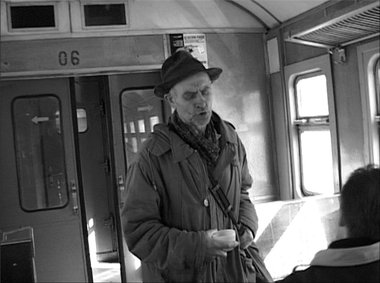
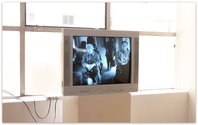
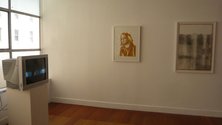
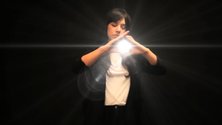
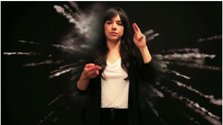

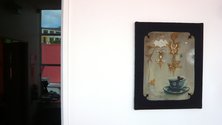
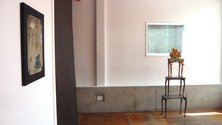
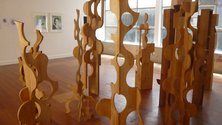
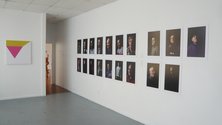
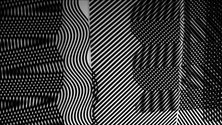

 Advertising in this column
Advertising in this column Two Rooms presents a program of residencies and projects
Two Rooms presents a program of residencies and projects



This Discussion has 0 comments.
Comment
Participate
Register to Participate.
Sign in
Sign in to an existing account.